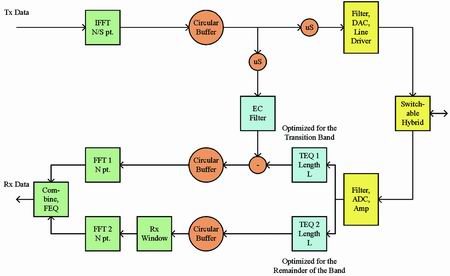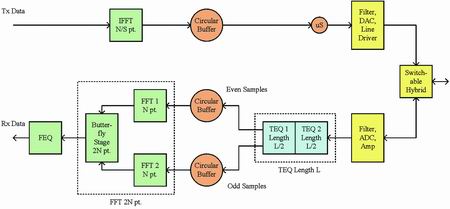Introduction The Asymmetric Digital Subscriber Line (ADSL) system is the most popular form of consumer DSL systems currently deployed. It supports data rates up to 12 Mbps in shorter loops. By extending the loop to 5.5Km or longer, a meaningful data rate can still be achieved by adjusting its rate and spectrum. However, many interferences reduce the coverage of ADSL, which creates loopholes in the network and fails to achieve acceptable service rates.

Figure 1 Example of a modem architecture optimized for longer loops
This article describes some of the ADSL modem design techniques that compensate for these types of interference, including inter-symbol interference (ISI), bridged taps, and radio frequency interference (RFI), as well as improved transmission spectrum to achieve longer coverage, minimize crosstalk, and solve Some new standards for mixing central office (CO) and remote terminal (RT) deployment issues. The continuous development of new standards, coupled with the introduction of a flexible modem architecture, allows operators to expand the field of DSL services offered at a certain target rate.
ADSL Foundation
ADSL converts a single wideband communication channel into multiple narrowband subchannels by using discrete multitone (DMT) modulation.
If the channel memory does not exceed the length of the cyclic prefix, a simplified prefix equalization of the receiver can be achieved using a cyclic prefix (before the IFFT signal is tailed to the block to be transmitted). In this case, equalization is simply complex multiplication by subchannels, eliminating channel effects.
For channel memory larger than the cyclic prefix, a channel shortening filter (called time domain equalizer or TEQ) is usually used in the designed receiver, so that most of the power of the TEQ in series with the channel is limited to the cyclic prefix length +1. . This is in contrast to the single channel case where a linear equalizer typically designs the minimum mean square error as a flip channel.
A typical ADSL deployment is Frequency Division Duplex (FDD), and a single channel (twisted pair) is used to carry two signals, which are connected to the transmitter and receiver of each modem through a hybrid circuit. Broadly speaking, hybrid circuits use four-to-two line switching with an isolation transformer. More specifically, the hybrid circuit performs analog echo cancellation to reduce transmission (or echo) reflections in the receiver. Hybrid echo suppression depends on the impedance of the reflected line (through the transformer), which in turn varies depending on the loop topology.
Interference compensation
The ADSL channel is affected by various interferences, and sometimes the data rate is even low to the extent that ADSL cannot be used from a commercial point of view (for example, it is difficult for us to introduce the 32 kbps rate as a broadband to the market). This section examines ISI, bridged taps, and RFI, and analyzes how to use appropriate modem designs to limit the impact of interference on ADSL systems.
ISI
The ISI in the ADSL channel is the result of a combination of twisted pair media and FDD filters. A TEQ that works well under strong ISI conditions near the transition zone may have grooves in frequency. Since noise propagates from the FFT, the groove causes SNR loss, which causes the data rate to drop.
One solution to the above problem is to use multiple receive paths with independent channel shortening equalizers, each optimized for different parts of the channel. For example, one TEQ can be designed for a stronger ISI transition band, while another TEQ can be designed for the rest of the band, where the ISI will be weaker, which will help achieve a smoother frequency response. After the FFT, the outputs of the two channels combine to form a single output of the subchannel (this is as simple as making a choice between the two channels).
Bridged taps Bridged taps refer to multiple distribution cables connected to a single feeder cable. Only one distribution cable is connected and the others remain open. While this architecture allows operators to flexibly distribute the line, bridged taps create impedance matching and reflection problems in the channel. Depending on the architecture, wiring in the home will have a similar effect.
The reflection of the transmitted signal caused by the bridged tap causes the echo component in the received signal to increase. Even if the ADSL system is operating in an FDD configuration, the echo enhancement (if not compensated) will result in a lower data rate. This is because in the case of a long loop, the echo power is greater than the received signal power, actually limiting the gain setting of the receiver, which increases the effective noise level of the modem. Moreover, the spread from the FFT allows one band to spread to other bands, as if there were additional sources of noise. Although the use of a sensitive band separation filter can help reduce the amount of diffused echo, it has the disadvantage of causing equalization problems for other receivers. In addition, it does not solve the modem noise level problem. Therefore, in dealing with the extra echoes caused by the bridged taps, a more reasonable approach is to take two steps.
First, in order to optimize the receiver dynamic range, the hybrid circuit must be adjusted to accommodate different reflected line impedances caused by varying loop topologies. In the simplest implementation, multiple hybrid circuits can be employed for different loop topologies to achieve this.
For the hybrid circuit to match the unremoved echo component, the echo canceller (EC) can be used to remove the remaining echo signals. The ADSL system can be designed to use traditional EC in the time domain or echo cancellation in the frequency domain (using some form of cyclic echo synthesis).
RFI
The RFI is caused by the coupling of RF signals in the ADSL band (0~1104 or 2208KHz). If the AM radio is coupled into the signal due to the incomplete balance of the twisted pair and the modem front end, the spread of the sinusoidal interfering signal of the FFT may cause a data rate drop in many subchannels. Therefore, it is necessary to develop some algorithms for processing the RFI.
The main standard for TEQ design is to shorten the channel. The MMSE-based TEQ design handles zero at a strong RFI source location. Although zeroing will reduce the rate, in general, the noise spread will drop significantly, and the cost reduction will be reasonable. Thus, if there is an RFI source when calibrating TEQ, TEQ can be used to compensate for the RFI.
The receiver open window is the second method available for RFI compensation. The receiver open window uses the information in the cyclic prefix to form a window that affects the noise. As long as the channel memory is shortened to the cyclic prefix minus the length of the window, the signal is not affected. Thus, what we get is a window with side lobes that decays much faster than a rectangular window. Therefore, even if the RFI occurs after modem calibration, the modem still exhibits high immunity to the harmful effects of RFI. The price it pays is the additional limit (lower freedom) that the channel shortens.

Figure 2 Modem architecture optimized for short loop (ADSL2+). Note that the combination of the two paths of the modem optimized for long loops constitutes TEQ and FFT operations.
Performance improvement based on transmission spectrum Since ADSL is based on DMT modulation, it has great flexibility in forming transmission bands. We can take advantage of this flexibility to improve the coverage of ADSL systems for handling mixed CO and RT deployments and minimizing crosstalk.
Larger spectrum shaping
The common shape of the DSL channel is such that the high frequency is more attenuated than the low frequency. In addition, channel attenuation increases as the loop length increases. Since the FDD ADSL system allocates higher frequencies to the downlink to improve the performance of ADSL over longer loops, it is often necessary to increase the downlink data rate.
ADSL2 is the second-generation ADSL, which solves the above problem with a specific accessory (range extended ADSL2), that is, using spectrum shaping to place power in a better place of the channel or to overlap the uplink and the downlink. The former can reduce the range of the downlink frequency or increase the power. Implementation, while the latter requires an EC. In addition, the uplink power reduces the frequency to avoid crosstalk and reduces the echo of the incoming downlink.
ADSL2+ handles CO and RT
Hybrid deployment situation Local loop unbundling makes it possible for one operator to provide services for a certain area from the CO while another operator can provide services to the same area from the RT. Since RT may be much closer to the end user than the CO, the crosstalk caused by RT can seriously affect the performance of the ADSL system running on the CO. Depending on the distance between the CO, the RT and the end user, and the coupling between the different lines, the impact on performance is different.
ADSL2+ is a new high-rate version of ADSL that doubles the width of the downstream bandwidth, providing a possible solution for mixed CO and RT deployments. The basic idea is to minimize the crosstalk caused by the lower frequency by allowing the formation of the ADSL2+ spectrum (possibly by simply turning off the subchannels). Due to the short loop, the ADSL2+ system deployed by the RT can achieve a reasonable rate even with only the higher subchannels. Correspondingly, if the ADSL system deployed by the CO is limited to the lower subchannel by the loop attenuation on the long loop, the crosstalk of the system from the ADSL2+ system deployed by the RT will be less, so it can still be realized reasonably. s speed.
Crosstalk minimization
ADSL2 follows the principle of making good neighbors for existing systems (CO and RT hybrid deployments are examples), providing more ways to minimize crosstalk. This includes the use of an upper-based power reduction mechanism to remove power while still maintaining the same data rate; it also includes an L2 mode that reduces transmission power when there is less data, and can be iterated by fully controlling the bit loading variation of the playback time. Iterate (stilla waterveing) to minimize crosstalk.
Flexible Architecture For the compensation of various disturbances in long loops, two paths can be used depending on the ISI observed on different parts of the channel. The EC can be used to design a path specifically for the transition band (which is where the echo is most), while the receiver window or TEQ design that reduces the RFI can be used for another path because the above interference will occur outside the transition band (see Figure 1). .
For the shorter loops where the above interference causes less problems, the two paths can be combined to double the number of subchannels that the system can handle. Assume that each cycle multiplication number that TEQ can provide is constant, and each of the two lengths L TEQ works at the R sample rate per second. When combined with the smallest logic, the single work at 2R rate can be obtained. Length L TEQ (split the filtering operation into two parts and use the delay). In addition, the odd-even samples of the TEQ output can be routed to an N-sized independent FFT, and the two FFT outputs can be combined, plus an additional butterfly stage to generate a 2N-size FFT (basically following time FFT derivative) Extract). In this way, a modem that can achieve efficient, high-speed operation of short loops is obtained, and can handle a large amount of interference in long loops (see Figure 2).
Conclusion The ADSL modem coverage has been expanded by combining flexible modem design with new ADSL standards. This paper summarizes some of the methods for compensating for general interference, plus the flexibility in the ADSL transmission spectrum, which greatly increases the data rate for all loop lengths.